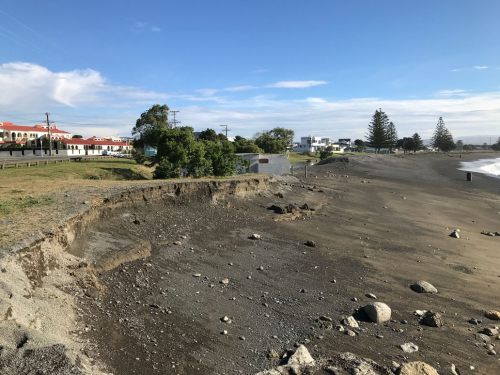


Being at the forefront of dealing with coastal hazard management issues is exciting, but it’s also challenging. We have to work through complex issues – who’s responsible for helping communities adapt, who pays for the planning, design and ultimately the physical works, how regulations and consenting requirements impact the work – with limited available guidance.
We all need our coastal communities, businesses, and infrastructure to be able to deal with the effects of the coastal hazards of erosion and inundation. But how do we support our communities to build resilience? What is the local extent of risks and potential hazards? How do we identify which areas need the most support? How do we fairly evaluate interventions for homes and infrastructure along the coast? These are the serious questions the coastal hazards strategy is working to answer.
So who’s responsible? It may look obvious, but one of the important questions we need to answer is who is responsible to implement the strategy, when each council has a role to play in the works.
The Coastal Hazard Joint Committee (with members from Napier City, Hastings District, and Hawke’s Bay Regional councils alongside Mana Ahuriri, Heretaunga Tamatea, and Maungaharuru Tangitū) commissioned Raynor Asher QC to review what this work aims to achieve, the current framework to deliver it – the Resource Management Act, Local Government Act, and council functions – and what the most effective model for implementing the coastal strategy could be.
Following his review of the legislation, case law, history and practical issues, and talking with council staff and councillors, Mr Asher recommended that Hawke’s Bay Regional Council take charge of all aspects of the prevention and mitigation of coastal hazards on the Clifton to Tangoio coast. This includes making decisions about rating for the works and collecting the rates, the implementation of all decisions including supervision of works, and the control of all maintenance.
Mr Asher also recommended that an advisory committee be formed, with mana whenua representation and elected members from Napier City, Hastings District, and Hawke’s Bay Regional councils, to support and give feedback to ongoing work under the strategy.
All three councils individually received, considered, and provided in-principle support for his findings.
The remaining step to close-out his findings and formalise responsibility is for a public consultation on the question: “Should Hawke’s Bay Regional Council implement the coastal hazard strategy with support and advice from mana whenua, and Napier City and Hastings District councils?”
Currently, the strategy has well-developed recommendations for how we might respond to coastal hazards over the next 100 years, but it isn’t yet part of any councils’ Long Term Plan. Long Term Plans are the main budgeting tool used by all councils to track and fund their activities.
We are planning to ask our coastal communities, mana whenua, and our wider community that question this year – so stay tuned.
Once this question has been answered by the community, we will then look at how we pay for the work, which is another complex piece of work that will take time to get right. Any decisions made around this will first go through a consultation process with our community.
The complexity of the strategy leads to decisions that aren’t always popular, for the wider good of the community, such as at Westshore. The recommendations of the community panel established for the Coastal Hazards Strategy included sand renourishment at Westshore. This would be further to the work already co-funded by the Regional Council (general rate) and Napier City Council (HB Land Endowment reserve) to add shingle to the beach crest and sand, when available from Port dredgings, in the nearshore marine area at Westshore. This programme has been further refined and costed in recent design work carried out as a part of the Strategy.
We’ve been working locally on the issue of coastal hazards since 2014. While we’ve achieved a huge amount together, we’re not as far along as we’d like, and we’ll continue to push forward on this massive, long-term project.
Thank you to our coastal community for your patience, support, and advice as we work through issues that haven’t been answered before in New Zealand.
Jerf van Beek
Chair of the Clifton to Tangoio Coastal Hazards Strategy 2120 Joint Committee
Disclaimers and Copyright
While every endeavour has been taken by the to ensure that the information on this website is
accurate and up to date, shall not be liable for any loss suffered through the use, directly or indirectly, of information on this website. Information contained has been assembled in good faith.
Some of the information available in this site is from the New Zealand Public domain and supplied by relevant
government agencies. cannot accept any liability for its accuracy or content.
Portions of the information and material on this site, including data, pages, documents, online
graphics and images are protected by copyright, unless specifically notified to the contrary. Externally sourced
information or material is copyright to the respective provider.
© - www.hbcoast.co.nz / /